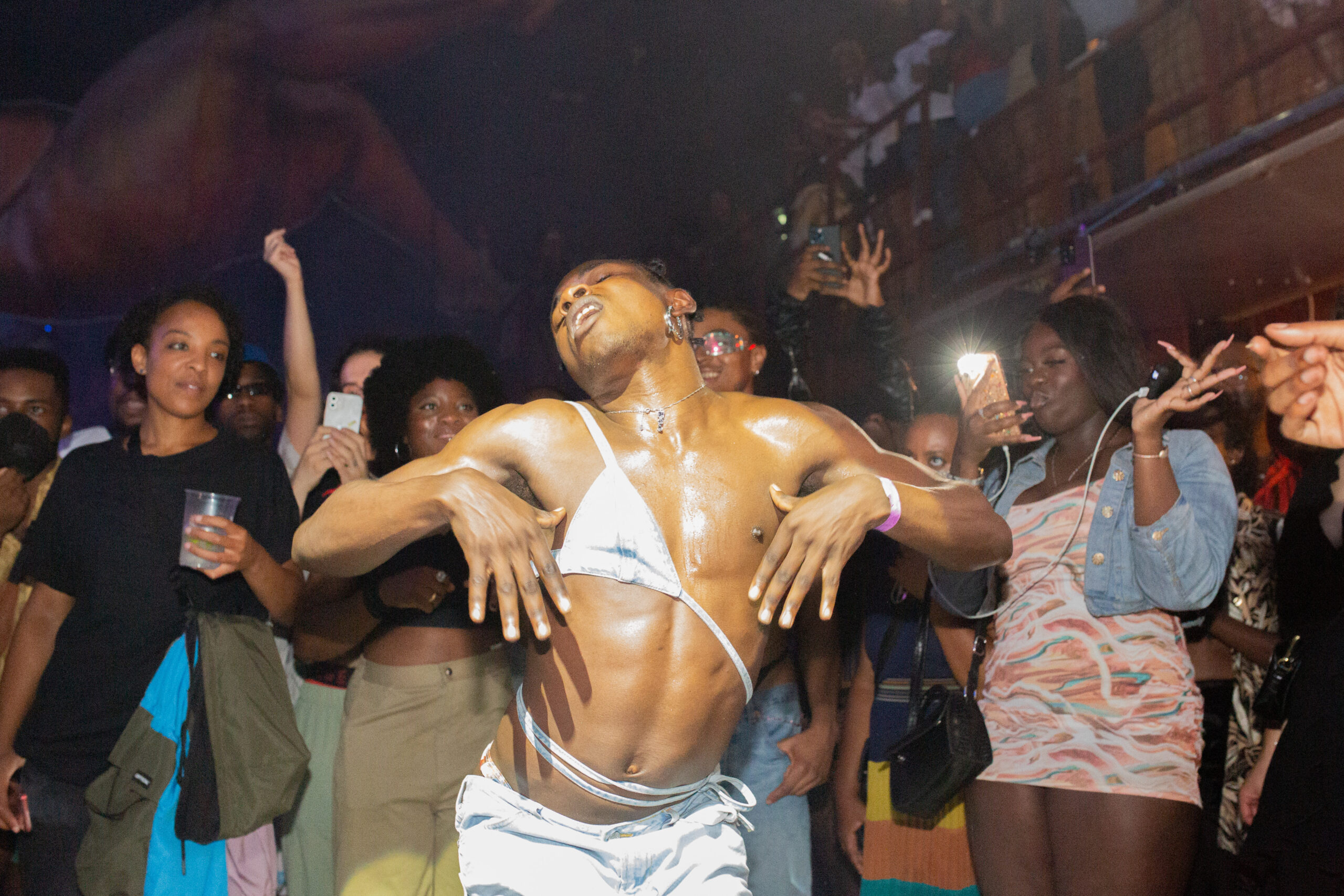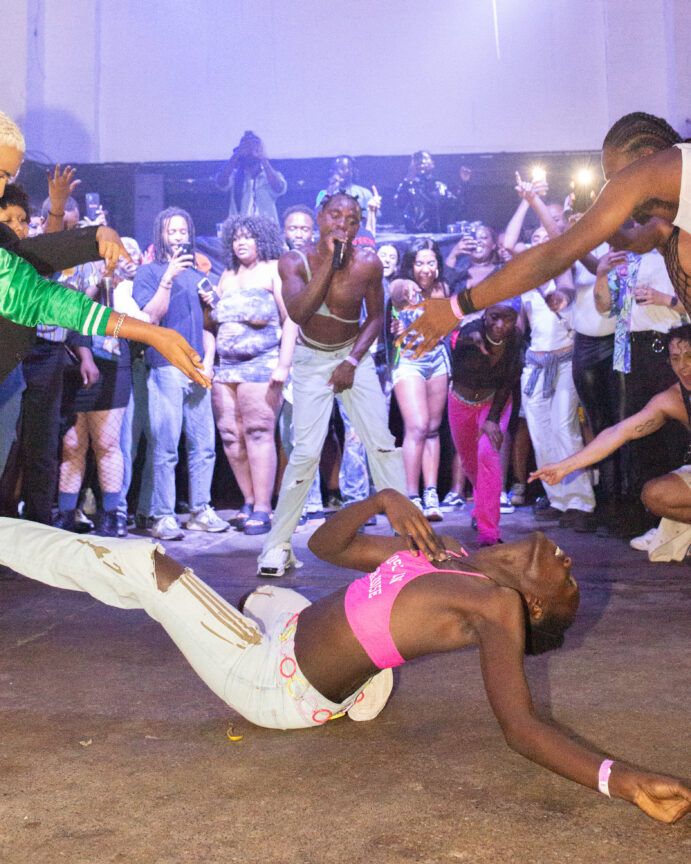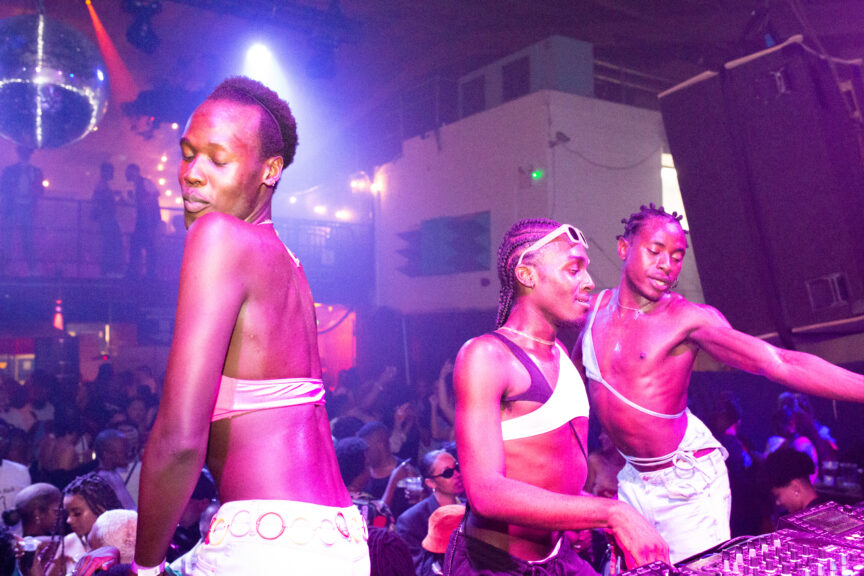Joy, for Me, Is the Black Queer Scene

SATURDAY 29 AUGUST 2020
Are you going or nah?
Cause I really don’t know lol
I really am undecided
It just doesn’t feel right to be
ayying on insta story right now . . .
If I go it’ll be last minute.
Within a few hours of these WhatsApp exchanges, my best friend, Jere Agbaje, and I were indeed ‘ayying’ on our Instagram stories, in attendance of a Black gay housewarming in Streatham Hill, hosted by our mutual friend Lyra. Mind you, this sea change from indifference to merrymaking wasn’t one of those standard emotional rituals that precede late-night motives, where you ebb and flow between hesitation, nonchalance and enthusiasm. When we’d begun messaging at around 7pm that day, we were miserable.
That morning, Black people across the world had woken up to yet another doom klaxon – that Chadwick Boseman had died following a private battle with colon cancer. Not to reduce the actor’s legacy to a singular role, but it felt manifestly cruel that in a year that had so far been defined by the endless theatre of Black death – families left bereaved by police brutality; Black people losing their lives to coronavirus after being viewed as a non-priority to enter ICUs in medical triage; Black expectant mothers dying suddenly, with their maternity shoots leaving us with a kind of techno-hauntology – Black Panther himself was gone.
I’d spent the day in bed, doomscrolling on Twitter, reading tributes, watching old videos of American children reacting to the news of a school trip to watch Black Panther, and laying digital flowers for a man who had come to embody Black diasporic unity.
Naturally, I didn’t feel like partying – I dismissed making space for joy in these circumstances as a frivolity. It just didn’t feel appropriate.
But what encouraged me to carry my load to Streatham Hill was that I hadn’t been on the scene in so long. I hadn’t seen my community: the Black gays, lesbians, bisexuals, queers and transgender people of London. By ‘the scene’, I mean the ever-shifting locations where we show face, congregate, gossip, brunch and whine.
The coronavirus pandemic had locked off everything. No Black queer raves, no house parties, no brunches, no Black Pride. “Black Pride being postponed has really hit me. Do you know how much the community looks forward to Black Pride? We talk about it year-round, I was even already thinking about outfits,” I tweeted on 23 March, knowing that ‘postponement’ didn’t mean an autumn or winter celebration; it meant the event wouldn’t be happening at all in 2020.
And Black Pride is Christmas Day for the community – I’d give anything to be there in Haggerston Park, like I was in 2019, showing off my newly muscled physique in tight shorts and an Adidas crop top, hoping that this would be the Pride to give me that blockbuster romantic moment where I finally meet my husband. So I knew that even if it felt heavy to lift myself out of this bed and this grief, I wouldn’t forgive myself if, for all my public lamentations, I didn’t swim across channels to reach the first Black gay social event since lockdown restrictions had been semi-relieved.
UK Black Pride is the place where we all belong. We are gutted we’re not with you all today, but this beautiful video from @lgbtrainbowfilm has really lifted us up.
We’d love to see your favourite moments from UK Black Pride. Reply below with #MyBlackPride! pic.twitter.com/Av0coq3sAs
— UK BLACK PRIDE (@ukblackpride) June 28, 2020
Building worlds.
Over the spring lockdown, Jere and I had reminisced about our early debuts on the scene. Among our broader Black queer social group, we’re the ‘baby gays’: kids of the Blair era among children of Thatcher and Major. So we felt especially mournful for the enjoyment we were missing, because those early years on the scene, before the full weight of employment and bills came crashing down on us in adulthood, were meant to be about pleasure-seeking and daring each other to dive off the speaker at the next rave.
I remembered some of those lawless nights we enjoyed. One of our fondest memories is Queer Bruk, an LGBTQIA+ dancehall night, which was being hosted at Vogue Fabrics Dalston – an airless sweatbox where a lack of ventilation didn’t prevent us from delivering and receiving the wickedest whines.
Onlookers who witnessed us emerge from the underground club, with steam rising from our foreheads, our clothes crumpled like foil, may have thought we had escaped an oven and not a basement. But the freedom and catharsis of the gay rave, of moving with freedom and without fear of judgement and harm, produces those delightful rhapsodies that transcend you from the heat and the sweat and the dark so you could just as well be dancing on clouds as in a dungeon; all that matters is that there are no mental chains or restraints.

These queer spaces are so joyful for me because it is world-making ambition and imagination that bring them into existence. These are spaces that render culture a religion and a sanctuary where one can escape that which perils us. It was the world-making ambitions of Queer Bruk’s founder and host, Akeil Onwukwe-Adamson, that allowed the space to blossom from humble beginnings in a small dungeon-like venue to sound systems, regular features on the radio and a more cabaret affair in larger dimensions, with vogue battles and catwalks. I remember seeing Akeil at that Queer Bruk in summer, emanating maximum drama by swanning around the venue in a pink tulle dress which remained poofy and elegant, refusing to be weighed downby the soaking humidity.
We love Akeil on the scene because he’s such a main character, so, of course, he wore the Big Pink Dress of the moment. Think Angela Bassett’s fuchsia Reem Acra gown at the Academy Awards in 2019, or Tracee Ellis Ross’s hot-pink Valentino cloud dress at the 2018 Emmys, or Rihanna’s princess-pink, empire-waisted, tiered, tulle Giambattista Valli frock at the Grammys in 2015.
View this post on Instagram
Akeil makes clear to me that the joy of this night is as much about celebrating himself as celebrating the rest of us Black queers. “Queer Bruk was always about me, primarily,” he waxes sentimental over voice notes and, I think, glasses of prosecco. “It was always about the music that I grew up on, and I just wanted to create a space which reimagined my life in Brighton. Which brought my queer world and my Black world together. And Queer Bruk is also about the music. It’s always been about African and Caribbean music, Afrobeats, dancehall, soca, and bringing those together in a queer world.”
Chasing nights.
The building of entire worlds within dance and music spaces for the safe and joyful expression of identity has a long history in Black Britain. Queer Bruk is but one of the latest expressions in a long genealogy of club nights. Speaking to Boyz magazine for Black History Month in 2016, legend of the scene Calvin Dawkins, otherwise known as DJ Biggy C, emphasized the importance of memory work as a community, to remember the spaces that we’ve built and lost over the years.
As a long-time resident DJ of the Black LGBTQIA+ night Bootylicious, which has been the nucleus of the Black queer scene since it premiered in the early 2000s, Biggy C commented to Boyz: “There has always been a vibrant and exciting club scene for Black LGBT people in London. However, it’s existed outside of the mainstream and, as a result, we have created our own.” But he also acknowledged that these nights often die out due to financial insecurity or dwindling public interest, meaning that the variety of the scene has in fact regressed over the years. “Twenty years ago there was more choice. We had spaces like Kudos, Fruit Machine, The Vox, Queer Nation, Low Down, Biessence and Caribana. And you could guarantee that there’d be at least two house parties every weekend.”
And indeed, much of our experience of the scene in terms of nightclubs is chasing these nights around London, as the lack of a fixed and permanent venue specifically for Black LGBTQIA+ people (unlike, say, the superclub G-A-Y Heaven) means that near enough any district of inner London could be the new mecca to which the Black gays complete their pilgrimage.
Bootylicious itself moved from Club Colosseum in Vauxhall to Electric in Brixton, and then back to Vauxhall again in Union Club. I remember regularly attending the club night Pxssy Palace with Jere at Mick’s Garage in Hackney and, after its increasing popularity meant it needed a larger venue, at The Garage in Islington.

The magic of the house party.
Despite the lifting of restrictions that summer, nightlife was not graced with a return, and so the scene has relied on the housewarmings, parties and gatherings like the one hosted by Lyra. Frankly, Black queer house parties have provided me with a kind of joy and intimate magic that is unmatched by other aspects of the scene. These parties, taking place on housing estates with predominantly Black British populations, remind me that the ends are a diverse home for Black queers, even if popular media refuse to see us.
These house parties have unhurried warmth. They’re where myths and legends of the scene are created and brought to a head. They’re where you truly get to know, and know about, people without the double-cheek-kiss-and-move-on speed and pretensions of more public spaces. My friend Derrien Layton, who debuted on the scene half a decade before I did, describes the unique magic of the house party to me: “My first experience of Black gay nightlife, in general, was a house party in 2011. I remember me and my friend Kwame went up to Bedford. And it was exciting for me because, obviously, the scene is so small here, we gossip amongst each other, there are a lot of legends and a lot of tales. So the house party was a space where I could finally put a face to these legends and these tales.
And it kind of doubles up as a reminder, especially for people who are just coming into their sexuality and just starting to make other Black gay friends, that it’s not just you in this world as a Black gay man. It kind of serves as a reminder that there’s magic in community. And that’s even if everybody doesn’t get on in that space, because that does tend to happen, as there can be arguments and disagreements and the like. But you know those disagreements and tensions aren’t because of your sexuality, so in that sense, regardless of your tensions, it will always be a safe space.”
It’s this element of myth and legend, of storytelling, narrative, names, faces and characters, that I describe as the ‘quiet joy’ of the scene. Don’t get me wrong, the house party of 29 August had so many loudly joyful moments. Singing in chorus to Nicki Minaj’s unreleased New Body verse, City Girls’ Act Up and Vybz Kartel’s Virginity, as queer Black women around me grinded on each other (no boy-on-boy action as I was, God knows why, the only gay boy at this house party – Lyra, I’m still mad about this!), was blissful and reminded me of just how much I missed dancing and DJs.
I adore how much we loudly gas each other up on the scene, complimenting a good beat, taking pictures, handing out gold medals for the smoothest waist movement. Umairah and Sameera, our South Asian friends within the broader scene of queers of colour, fed us with the most deliciously spiced chicken wings, which we were all dying to know the recipe for. And I can’t not let my audience know that the Black queer ladies told me that I, without competition, “have the best ass in south London”.
This said, I felt most content and joyful in those quiet moments of reflection when I absorbed my surroundings and realized just how much the architecture of the Black queer scene made possible for me. I grew up with a very early and very doomed sense of my sexuality, and I couldn’t have ever imagined being in a community with an entire pantheon of people like me. And while I’m now a very confident Black gay man, there was once a boy who thought he existed alone in this world. In those quiet moments, you can speak, think and feel with real clarity.
Didn’t even realise how much my spirit needed last night, being away from the community and not seeing the regulars on the Black queer scene has actually been such a loss these past months
— Jason Okundaye (@jasebyjason) August 30, 2020
Bubbles of love.
The storytelling that takes place in the breakout rooms when you take a breather from the dancing is always my favourite aspect of house parties. Lingering in a breakout room is often unfairly described as antisocial, but it’s here that you crack jokes, catch up on gossip, let people know about your plans and your dreams and how much you love them. I remember Jere and I popping upstairs and chatting for what felt like hours with Lyra and her girlfriend, Maya, talking about whether we’d assimilate into the institution of marriage, speculating on who will have the first Black queer wedding (streets are saying it’s Rose), gushing about Jere’s and Maya’s careers, about Lyra’s upcoming projects and photography, about my ambitions to write and one day produce documentaries and dramas.
It’s in these bubbles of love, when you find those brief moments of time to appreciate the blessing of being in community, of having a ‘scene’ at all, that joy surfaces in the chaos as a cooling, calming, ontological affirmation of life and the value of togetherness. The joyful chaos of parties and club nights is a kind of ecstasy, but it is incomplete without the smoking areas and bedrooms where we bond and get to know each other.
Equally, the more perilous chaos of an anti-Black world, one which often forces us to surrender into retreat and isolation, doomscrolling on our phones, being force-fed the bodies of the dead, anxious about the next terror, can be quelled by the resolute determination to continue dancing, and laughing, and dreaming, and sharing stories.
Jere lucidly recalls her emotions from that night at Lyra’s – she’s clear that the scene had brought her joy as comfort in a time that had been indexed by social isolation and collective mourning. “Attending Lyra’s house party was absolutely surreal. It felt so special to exist as my entire self, and to just feel so vibrant and present in that moment.” These words from Jere reminded me of the sanctity of those spaces where you can be “your entire self” for those Black LGBTQIA+ people who don’t have the luxury of self-expression at home with their biological families.
As so many of us have existed or continue to exist within these constraints, parties like Lyra’s give us something to believe in. “It just felt like a morning stretch on a warm summer’s day,” Jere continues, “with the sun shining and all the warm happy things that we tend to think of coming together at once. It was building bonds, seeing people that you’ve built bonds with online, because of our shared community, actually seeing them in the present and what they look and feel and sound like.
“And it sounds ridiculous, but I wasn’t expecting much as well,” she says, remembering our mutual hesitation at attending. “I remember being on the train and trying to grin my way into putting on a facade of being present and sociable, and immediately, when I did get there, that just washed away. I think it made me realize just how important these physical spaces are and how much we take them for granted, because lockdown took them entirely away.”
The safety of community.
Joy for me is in the quiet of this realisation. It is in the knowing that there is a community of love, of celebration, not mere tolerance and acceptance, in which your interior self is your exterior self. Joy is in the peace and safety of community and togetherness. I can’t stop thinking about how wonderful the scene is, and how much happier my life is for having found it.
Right now, I miss my Black gays and my gays of colour. Jere, Isi, Cleveland, Lyra, Maya, Derrien, Tosin, Martha, Nana, Rose, Twiggy, Umairah, Sameera, Paul, Ismail, Tanya, Marc, Tochi, Che, Nadia, Zareen, Timi. I miss seeing them at the nightclubs, the dinners, the lunches, the brunches, the birthdays, the parties, the coffee catch-ups. They are my scene, and they are my joy.
Jason Okundaye is a writer and journalist.
Photos are by Jeremiah Fernandes.
This is an extract from Black Joy, edited by Charlie Brinkhurst-Cuff and Timi Sotire, and published by Penguin.


